最近在做物联网平台的协议开发,但是因为前端设备厂家较多,而且根据使用的场景和使用的用途,协议也大小不一,各种各样的协议都有,但是为了来兼容这些协议,必须要设计一些插件或者脚本来自动进行数据的解析和数据的封装。然后调查了一下,市面上使用较为广泛的是lua和js,这两个脚本型语言使用的人生较多,用起来也比较容易上手。
然后在对脚本支持上就麻烦了,毕竟没有没有那么多的时间来做这方面的工作。然后在网站找了相关资料,还是决定从LuaJit入手,毕竟之前一直在做嵌入式的开发,对C的移植和使用也比较熟悉,然后使用LuaJit运行的时间也比较款,因此决定,还是从LuaJit下手。
我们简单的来看看LuaJit的相关知识和优缺点。
一、LuaJIT主要由以下四部分组成:
语法实现。
Trace JIT编译器。
库函数。
原生库++(强化过的原生库)
bit
ffi
jit
字节码。
注:最新luajit对应lua5.1.5。
二、为什么要使用LuaJit
解释执行:
效率低。
代码暴露。
静态编译:
不够灵活,无法热更新。
平台兼容性差。
JIT:
效率:高于解释执行,低于静态编译。
安全性:一般都会先转换成字节码。
热更新:无论源码还是字节码本质上都是资源文件。
兼容性:虚拟机会处理平台差异,对用户透明。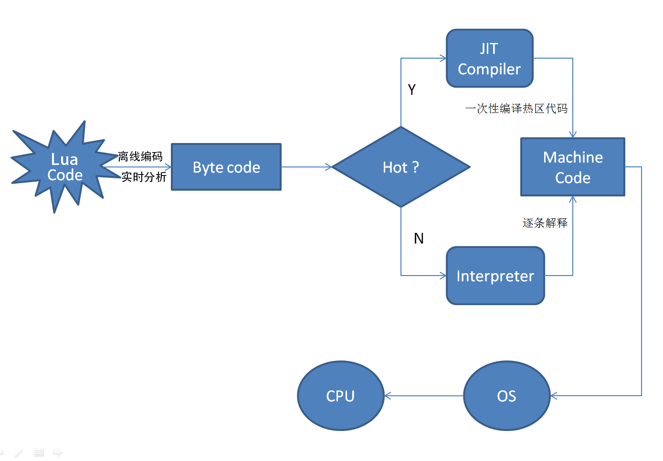
三、GO和Lua通信的桥梁---->C语言
为了快速打通Go和Lua的使用途径,决定举出大宝剑C语言,毕竟C属于较为底层的语言,各个语言为了实现某些高效率的场景,都有支持C语言,因此决定,从C语言入手,以C语言为桥梁,沟通Go语言和Lua语言,接下来我们看如何在Go语言中使用C语言。
1、启用 CGO 特性
在 golang 代码中加入 import “C” 语句就可以启动 CGO 特性。这样在进行 go build 命令时,就会在编译和连接阶段启动 gcc 编译器。
// go.1.15// test.go
package main
import "C" // import "C"更像是一个关键字,CGO工具在预处理时会删掉这一行
func main() {
}
说明:
当你在包中引用 import "C",go build 就会做很多额外的工作来构建你的代码,构建就不仅仅是向 go tool compile 传递一堆 .go 文件了,而是要先进行以下步骤:
1)cgo 工具就会被调用,在 C 转换 Go、Go 转换 C 的之间生成各种文件。
2)系统的 C 编译器会被调用来处理包中所有的 C 文件。
3)所有独立的编译单元会被组合到一个 .o 文件。
4)生成的 .o 文件会在系统的连接器中对它的引用进行一次检查修复。
cgo 是一个 Go 语言自带的特殊工具,可以使用命令 go tool cgo 来运行。它可以生成能够调用 C 语言代码的 Go 语言源文件,也就是说所有启用了 CGO 特性的 Go 代码,都会首先经过 cgo 的"预处理"。
2.Go 调用自定义 C 程序
// test_call_c.go
package main
/*
#cgo LDFLAGS: -L/usr/local/lib
#include <stdio.h>
#include <stdlib.h>
#define REPEAT_LIMIT 3 // CGO会保留C代码块中的宏定义
typedef struct{ // 自定义结构体
int repeat_time;
char* str;
}blob;
int SayHello(blob* pblob) { // 自定义函数
for ( ;pblob->repeat_time < REPEAT_LIMIT; pblob->repeat_time++){
puts(pblob->str);
}
return 0;
}
*/
import "C"
import (
"fmt"
"unsafe"
)
func main() {
cblob := C.blob{} // 在GO程序中创建的C对象,存储在Go的内存空间
cblob.repeat_time = 0
cblob.str = C.CString("Hello, World\n") // C.CString 会在C的内存空间申请一个C语言字符串对象,再将Go字符串拷贝到C字符串
ret := C.SayHello(&cblob) // &cblob 取C语言对象cblob的地址
fmt.Println("ret", ret)
fmt.Println("repeat_time", cblob.repeat_time)
C.free(unsafe.Pointer(cblob.str)) // C.CString 申请的C空间内存不会自动释放,需要显示调用C中的free释放
}
CGO 会保留序文中的宏定义,但是并不会保留注释,也不支持#program,C 代码块中的#program 语句极可能产生未知错误。
CGO 中使用 #cgo 关键字可以设置编译阶段和链接阶段的相关参数,可以使用 ${SRCDIR} 来表示 Go 包当前目录的绝对路径。
使用 C.结构名 或 C.struct_结构名 可以在 Go 代码段中定义 C 对象,并通过成员名访问结构体成员。
test3.go 中使用 C.CString 将 Go 字符串对象转化为 C 字符串对象,并将其传入 C 程序空间进行使用,由于 C 的内存空间不受 Go 的 GC 管理,因此需要显示的调用 C 语言的 free 来进行回收。
四.编译LuaJit库文件
1. 安装 TDM-GCC。
下载并安装 TDM-GCC 编译器 :
下载地址 : tdm-gcc
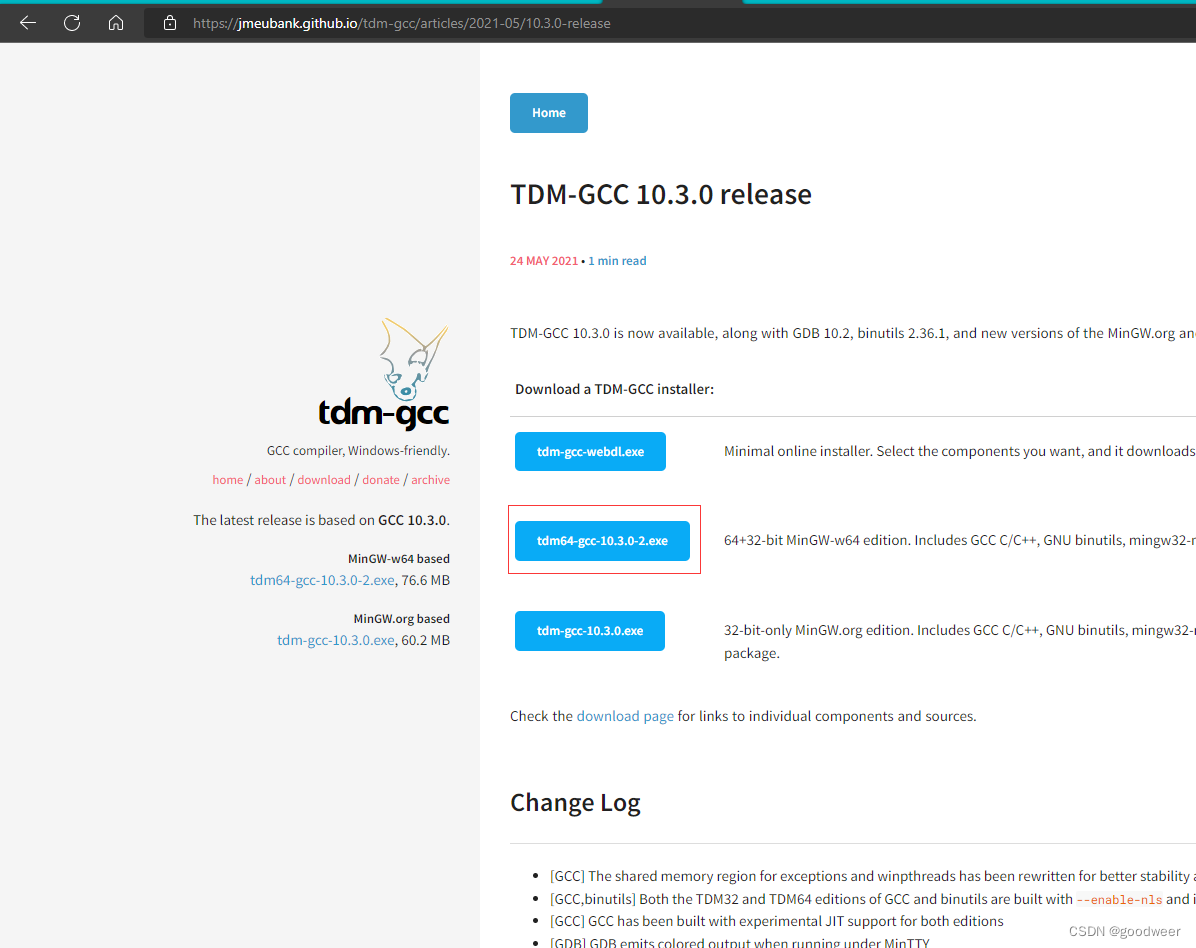
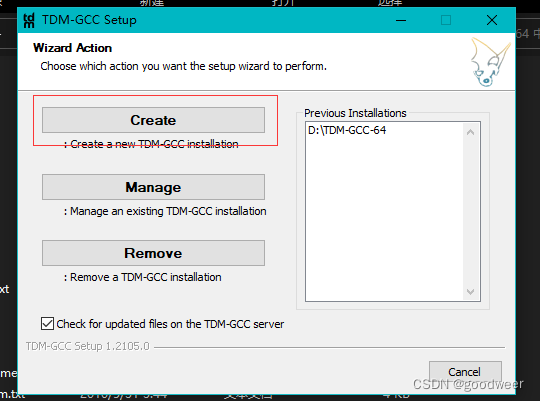
选择支持32位和64位的版本版本
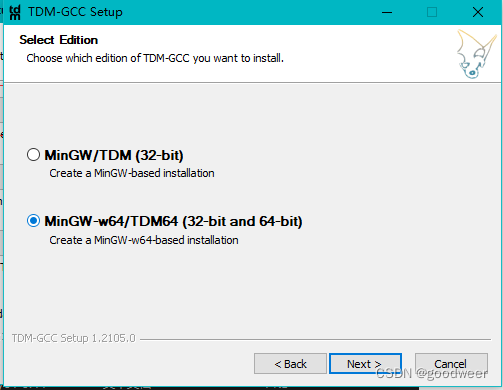
设置安装路径
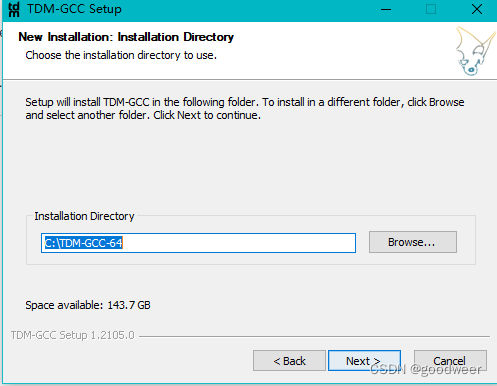
全部选择
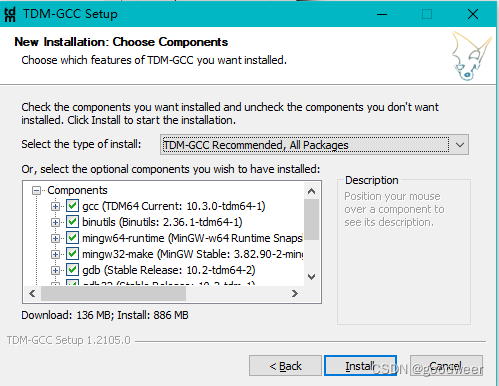
然后等待安装完成,安装完成之后,配置应用程序的路径:

编译源代码并生成库文件
mingw32-make
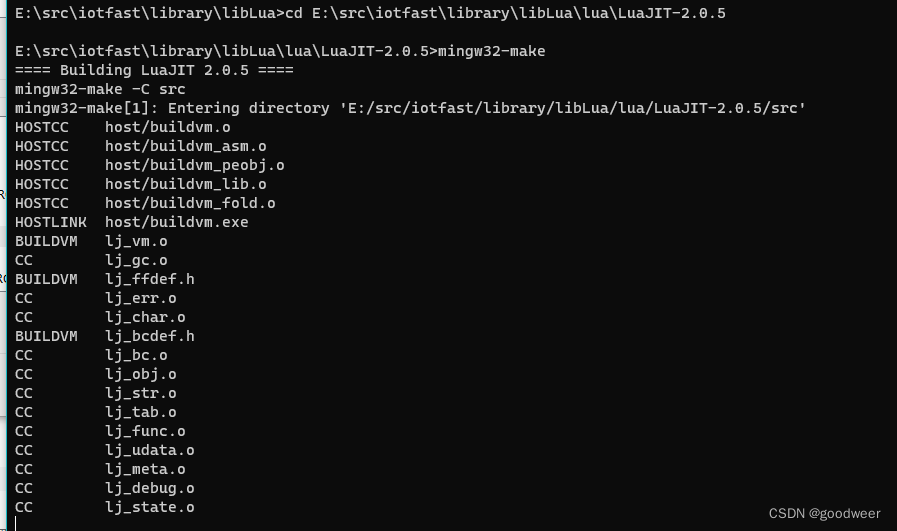
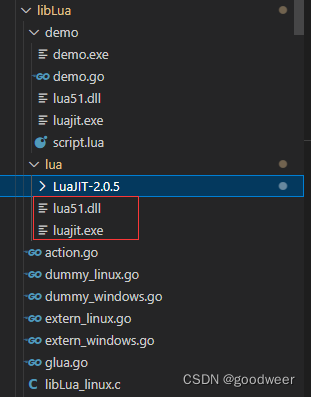
五、go调用lua支持
#include <luajit.h>
#include <lua.h>
#include <lauxlib.h>
#include <lualib.h>
#include <stdio.h>
#include <stdlib.h>
#include "_cgo_export.h"
extern int sync_extern_method(lua_State* _L);
int gluaL_dostring(lua_State* _L, char* script) {
int res = luaL_dostring(_L, script);
free(script);
return res;
}
void glua_getglobal(lua_State* _L, char* name) {
lua_getglobal(_L, name);
free(name);
}
void glua_setglobal(lua_State* _L, char* name) {
lua_setglobal(_L, name);
free(name);
}
void glua_pushlightuserdata(lua_State* _L, void* obj) {
lua_pushlightuserdata(_L, obj);
}
int glua_pcall(lua_State* _L, int args, int results) {
return lua_pcall(_L, args, results, 0);
}
lua_Number glua_tonumber(lua_State* _L, int index) {
return lua_tonumber(_L, index);
}
int glua_yield(lua_State *_L, int nresults) {
return lua_yield(_L, nresults);
}
const char* glua_tostring(lua_State* _L, int index) {
return lua_tostring(_L, index);
}
void glua_pop(lua_State* _L, int num) {
lua_pop(_L, num);
}
lua_State *glua_tothread(lua_State* _L, int index) {
return lua_tothread(_L, index);
}
int glua_istable(lua_State* _L, int index) {
return lua_istable(_L, index);
}
void* glua_touserdata(lua_State* _L, int index) {
return lua_touserdata(_L, index);
}
int glua_resume (lua_State *_L, int narg) {
return lua_resume(_L, narg);
}
int glua_gettop(lua_State *_L) {
return lua_gettop(_L);
}
int glua_gc (lua_State *_L, int what, int data) {
return lua_gc(_L, what, data);
}
lua_State *gluaL_newstate (void) {
return luaL_newstate();
}
void gluaL_openlibs (lua_State *_L) {
luaL_openlibs(_L);
}
lua_State *glua_newthread (lua_State *_L) {
return lua_newthread(_L);
}
void glua_close (lua_State *_L) {
lua_close(_L);
}
void glua_remove (lua_State *_L, int index) {
lua_remove(_L, index);
}
int glua_type (lua_State *_L, int index) {
return lua_type(_L, index);
}
void glua_pushlstring (lua_State *_L, char *s, size_t len) {
lua_pushlstring (_L, s, len);
free(s);
}
void glua_pushnumber (lua_State *_L, lua_Number n) {
lua_pushnumber(_L, n);
}
void glua_pushboolean (lua_State *_L, int b) {
lua_pushboolean(_L, b);
}
void glua_pushnil (lua_State *_L) {
lua_pushnil(_L);
}
void glua_createtable (lua_State *_L, int narr, int nrec) {
lua_createtable(_L, narr, nrec);
}
void glua_settable (lua_State *_L, int index) {
lua_settable (_L, index);
}
int glua_next (lua_State *_L, int index) {
return lua_next(_L, index);
}
int glua_toboolean (lua_State *_L, int index) {
return lua_toboolean(_L, index);
}
void register_go_method(lua_State* _L) {
lua_pushcfunction(_L, &sync_extern_method);
lua_setglobal(_L, "sync_extern_method");
}
添加跨平台支持
.
六 、编写测试文件
1.go语言文件内容如下:
package main
import (
"context"
"encoding/json"
"fmt"
"time"
"github.com/xiaodingding/iotfast/library/libLua"
)
func test_sum(ctx context.Context, args ...interface{}) (interface{}, error) {
sum := 0
for _, arg := range args {
sum = sum + int(arg.(int64))
}
if sum%2 == 0 {
return sum, nil
} else {
return nil, fmt.Errorf("bad sum")
}
}
func json_decode(ctx context.Context, args ...interface{}) (interface{}, error) {
raw := args[0].(string)
var res map[string]interface{}
err := json.Unmarshal([]byte(raw), &res)
return res, err
}
func main() {
fmt.Println("start main")
libLua.RegisterExternMethod("json_decode", json_decode)
libLua.RegisterExternMethod("test_sum", test_sum)
s := time.Now()
fmt.Println("time:", s)
res, err := libLua.NewAction().WithScript(`
function fib(n)
if n == 0 then
return 0
elseif n == 1 then
return 1
end
return fib(n-1) + fib(n-2)
end
`).WithEntrypoint("fib").AddParam(35).Execute(context.Background())
fmt.Println(time.Now().Sub(s))
fmt.Println(res, err)
s = time.Now()
res, err = libLua.NewAction().WithScriptPath("./script.lua").WithEntrypoint("fib").AddParam(35).Execute(context.Background())
fmt.Println(time.Now().Sub(s))
fmt.Println(res, err)
s = time.Now()
res, err = libLua.NewAction().WithScriptPath("./script.lua").WithEntrypoint("fibt").AddParam(35).Execute(context.Background())
fmt.Println(time.Now().Sub(s))
fmt.Println(res, err)
s = time.Now()
res, err = libLua.NewAction().WithScriptPath("./script.lua").WithEntrypoint("test_args").AddParam([]interface{}{69, 56}).Execute(context.Background())
fmt.Println(time.Now().Sub(s))
fmt.Println(res, err)
s = time.Now()
res, err = libLua.NewAction().WithScriptPath("./script.lua").WithEntrypoint("async_json_encode").Execute(context.Background())
fmt.Println(time.Now().Sub(s))
fmt.Println(res, err)
s = time.Now()
res, err = libLua.NewAction().WithScriptPath("./script.lua").WithEntrypoint("test_pull_table").AddParam(69).Execute(context.Background())
fmt.Println(time.Now().Sub(s))
fmt.Println(res, err)
fmt.Println("end main")
}
2.lua语言内容如下:
function fib(n)
if n == 0 then
return 0
elseif n == 1 then
return 1
end
return fib(n-1) + fib(n-2)
end
function fibt(n)
return fibc(n, 0, 1)
end
function fibc(n, a, b)
if n == 0 then
return a
else
if n == 1 then return b end
end
return fibc(n-1, b, a+b)
end
function test_args(n)
res, err = sync_extern_method('test_sum', 1,2,3,4,5,6,n[1],n[2])
if err == nil then
return res
else
error(err)
end
end
function test_pull_table(obj)
return {a=true, b=123, c='hello luajit', d={e=12, f='good golang'}, e={1,2,3,4,4}, 1, m=obj}, nil
end
function async_json_encode()
return coroutine.yield('json_decode', '{"a":"ads","b":12,"c":"sadh"}', 'hello world')
end
3.文件夹内容结构
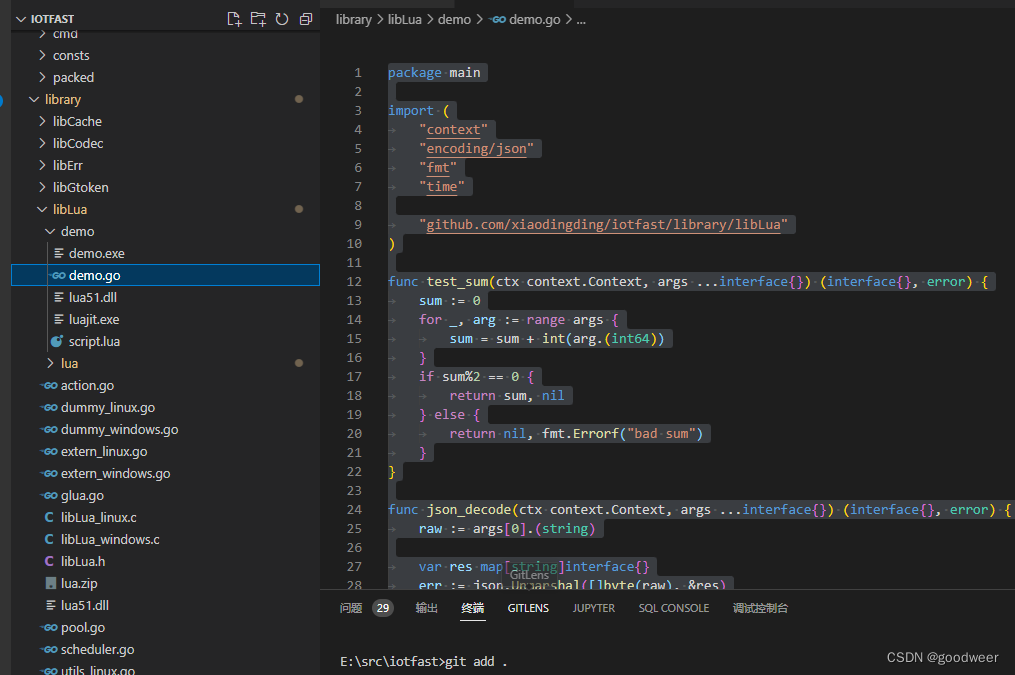
4.windows下运行测试
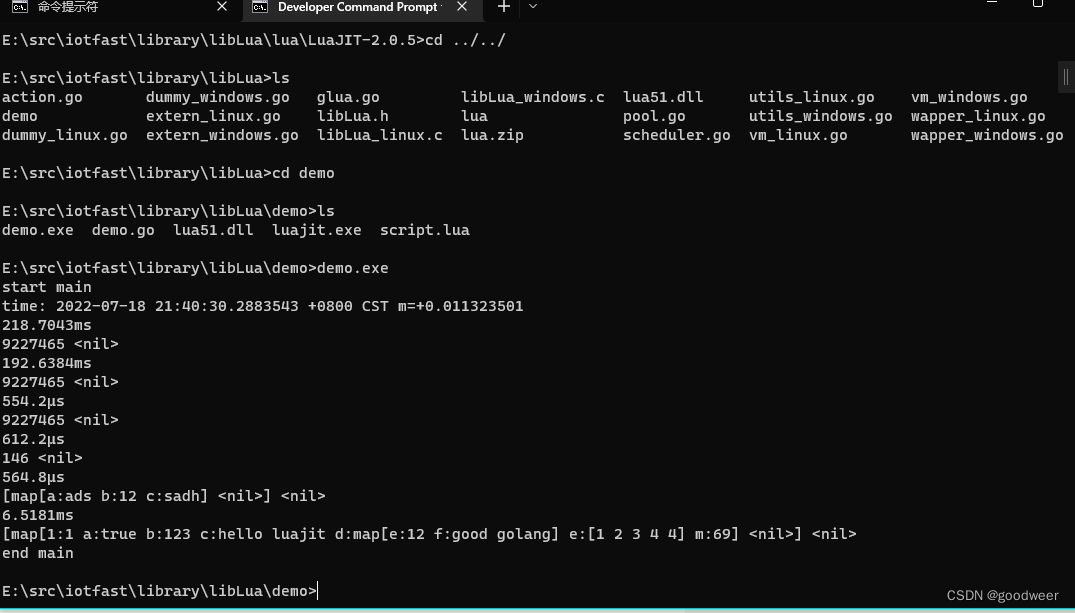
Windos测试通过。
5.Linux下运行测试类似于Windows。
TRANSLATE with